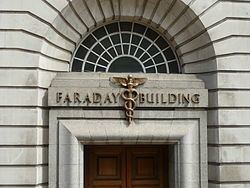 | ||
Similar Charwelton BT Tower, Stokenchurch BT Tower, Tinshill BT Tower, Guardian telephone exchange, Heaton Park BT Tower | ||
The Faraday Building was the GPO's first telephone exchange in London. It started life as the Central telephone exchange at the Savings Bank building in Queen Victoria Street, opening for business on 1 March 1902 with just 200 subscribers. The Faraday Building is erected on the former site of Doctors' Commons, which had been the location of the Admiralty, Probate, and principal Ecclesiastical Court in England.
The Post Office’s first London telephone exchange served nearly two-and-a-half square miles of the capital – notable subscribers included the Treasury, the War Office and Fleet Street.
Take-up of the telephone by the public was very quick so that by 1905 the exchange capacity was extended to 10,000 subscribers, and full capacity was exhausted just three years later.
To meet the growing demand from businesses in the City, a new common battery exchange was installed in 1906 with a capacity of 15,000 lines. This became 'City' exchange and officially opened in November 1907.
In common with other exchanges in London, Central was able to connect subscribers to the Electrophone exchange at Gerard Street. Electrophone allowed people to listen to performances at certain London theatres and music halls while sitting at home.
In 1933, Faraday became the telephone centre of the world with the opening of the international telephone exchange.
In 1935, an automatic exchange was opened with more than 6,000 working lines. The complex task of switching subscribers over to the new exchange involved 60 engineers and the opening was the culmination of more than 15 months’ hard work.
The construction of the Faraday Buildings obscured the riverside view of St Paul's Cathedral and directly led to the legislation protecting the views of St Paul's that has been used to thwart large buildings being erected around the various vantage points to see the cathedral. The City of London School and another telephone exchange, Baynard House were built between the riverside and Faraday House but are restricted in height to just three levels above ground.
During the second world war, the Faraday Building was transformed into a redoubt where the Cabinet could retreat if the need arose and the Prime Minister run the war in greater security than Downing Street could provide.
